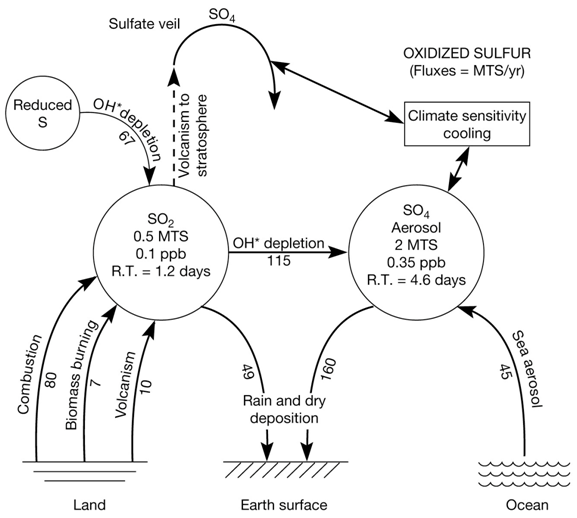Aerosols
Aerosols are very small airborne particles, either liquid or solid, that can be produced naturally from volcanoes, wildfires, windblown dust of soils, land and ocean emissions of biologically produced gases, and sea-salt spray. The size and distribution of the aerosols are critical to their influence on climate and there is great spatial and temporal variability in aerosol concentrations. In addition, aerosols overall have short atmospheric lifetimes, which suggests that they should not be considered or relied upon to act in such a way as to offset long-term greenhouse warming. Generally speaking, the larger the number of aerosol particles, the greater the amount of the sun's radiation is reflected back in to space and thus aerosols most likely produce a cooling effect on climate. Aerosols can cool by (1) reflecting incoming radiation back to space, and (2) serving as cloud condensation nuclei for certain cloud types that reflect radiation back to space.
An example of the global cooling effect that aerosols can have on climate is the 1815 eruption of Tambora volcano in Indonesia. The dust and aerosol produced by the eruption entered the stratosphere and reduced the solar radiation reaching the planet. In 1816, because of late snows and continuous rains, Europe experienced a year without a summer. The cool conditions continued in Europe for three years after the eruption resulting in massive crop failures, subsequent starvation, and near collapse of society in Europe.
Biological emissions of sulfur gases from the land and ocean surface also can lead to creation of aerosols in the atmosphere and hence affect climate. These emissions are dominated by dimethylsulfide (DMS), hydrogen sulfide (H2S), and carbonyl sulfide (OCS). The biogenic gases can be oxidized to sulfur dioxide gas in the atmosphere and then to sulfate aerosol.
The major source of cloud condensation nuclei in the atmosphere above the ocean is dimethylsulfide gas escaping the sea surface. The magnitude of the dimethylsulfide flux is related to ocean (via phytoplankton) primary production and bacterial degradation of the organic products derived from primary production. One hypothesis put forth related to the feedback between dimethylsulfide emissions and climate is that if the Earth warms, then phytoplankton production will increase. This increase would lead to an increased flux of dimethylsulfide to the atmosphere, which in turn would result in more formation of sulfate aerosols and thus cloud condensation nuclei. The increased production of cloud condensation nuclei and therefore degree of cloudiness would lead to reflection of solar radiation and hence to cooling of the atmosphere (specifically the troposphere). This is a negative feedback (a negative feedback is a process or mechanism that diminishes a change in a system) to global warming.
Industry, biomass and fossil fuel burning and the resultant emission of sulfur dioxide can lead to formation of sulfate aerosols that contribute to tropospheric sulfate aerosols (Figure 14). These aerosols potentially could have a cooling effect on climate. It has been argued that the enhanced anthropogenic emissions of sulfur dioxide to the atmosphere, especially in the northern hemisphere, have helped cool the planet during the twentieth century. If this is true, the cooling effect may have offset part of the expected temperature increase owing to anthropogenic emissions of greenhouse gases to the atmosphere, especially over industrialized areas (Figure 15).
Figure 14. Earth surface-atmosphere global biogeochemical cycle of oxidized sulfur species. Sulfur dioxide (SO2) released from the land surface to the atmosphere reacts with hydroxyl radical (OH) to form sulfate (SO4) aerosol. Sulfate aerosol, directly or indirectly, potentially exerts a cooling influence on the climate. Flux values are in units of million tons of sulfur per year. Note how large the combustion flux (due to human activities) is compared to the natural process of volcanism, which is the emission from volcanic activity.
Figure 15. Annual anthropogenic global emissions of sulfur and nitrogen as SOx and NOx to the atmosphere from the burning of fossil fuels, and for sulfur from the smelting of sulfide ores from 1860 to 2000. An estimate of the natural biological sulfur flux (dashed line) and natural nitrogen flux (red line) to the atmosphere is given for comparison.
Summary
The current concern about the greenhouse effect and climate stems from the amount of greenhouse gases that are being released into the atmosphere from the burning of fossil fuels, deforestation, agricultural and industrial practices, release of synthetic chlorofluorocarbons, and other humankind activities. Accumulation of these heat-absorbing greenhouse gases in the atmosphere can result in an enhanced greenhouse effect and consequent global warming induced by human activities. The concern is that an enhanced greenhouse effect may elevate global temperatures above levels that have not occurred for hundreds of thousands of years. The degree to which the accelerating rate of increase of greenhouse gases in the atmosphere will impact our climate is a topic of much debate and uncertainty because of the many variables that are involved in the climate system and their feedbacks.
In an effort to determine what effects these human-induced changes to greenhouse gas concentrations could have on climate, sophisticated computer models have been developed by the scientific community and are continually refined. In 1990, 1995, and 2001 the Intergovernmental Panel on Climate Change released three reports intended to provide information on not only how climate has changed over human times, but also how it might change in the future, and given the range of projected future change, what would be the resultant impacts – e.g., environmental, economic, social, political, etc. – for the world’s population. The climate forecasts in these reports are based upon the projections from large-scale global climate models. The first two Intergovernmental Panel on Climate Change reports, and their climate forecasts, led to the 1997 Kyoto Protocol, which is discussed in the next chapter - Chapter 3.


